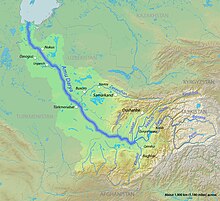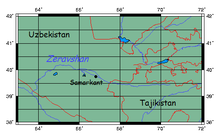The Zarafshon[2][a][b] (Uzbek & Tajik: Зарафшон, Romanized: Zarafshon) is a river in Tajikistan and UzbekistaninCentral Asia. Its name, "spreader of gold" in Persian, refers to the presence of gold-bearing sands in the upper reaches of the river. To the ancient Greeks it was known as the Polytimetus.[3] It was also formerly known as Sughd River. The river is 877 kilometres (545 mi) long and has a basin area of 17,700 square kilometres (6,800 sq mi).[4]
| Zarafshon | |
|---|---|

The Zarafshon in Ayni District, Tajikistan
| |

The Zarafshon in the Amu Darya basin
| |
|
Mouth | |
| Location | |
| Country | Tajikistan, Uzbekistan |
| Physical characteristics | |
| Source | Zeravshan Glacier |
| • coordinates | 39°30′N 70°35′E / 39.500°N 70.583°E / 39.500; 70.583 |
| Mouth | Qorakoʻl oasis |
• coordinates | 39°32′52″N 63°52′08″E / 39.5477°N 63.869°E / 39.5477; 63.869 |
| Length | 877 km (545 mi) |
| Basin size | 17,700 km2 (6,800 sq mi) |
| Basin features | |
| Cities | Panjakent, Samarkand, Bukhara |
| Tributaries | |
| • left | Fan Darya, Kshtut, Magiyan |


It rises at the Zeravshan Glacier, close to where the Turkestan Range and the Zeravshan Range of the Pamir-Alay mountains meet, in Tajikistan. In its upper course, upstream from its confluence with the Fan Darya, it is also called Matcha.[5] It flows due west for some 300 kilometres (190 mi), passing Panjakent before entering Uzbekistanat39°32′N 67°27′E / 39.533°N 67.450°E / 39.533; 67.450, where it turns west-to-north-west, flowing past the legendary city of Samarkand, where it feeds the Dargom Canal, which is entirely dependent on the oasis thus created, until it bends left again to the west north of Navoiy and further to the south-west, passing Bukhara before it is lost in the desert beyond the city of Qorakoʻl (Karakul), not quite reaching the Amu Darya, of which it was formerly a tributary.
This article related to a river in Uzbekistan is a stub. You can help Wikipedia by expanding it. |
This article related to a river in Tajikistan is a stub. You can help Wikipedia by expanding it. |